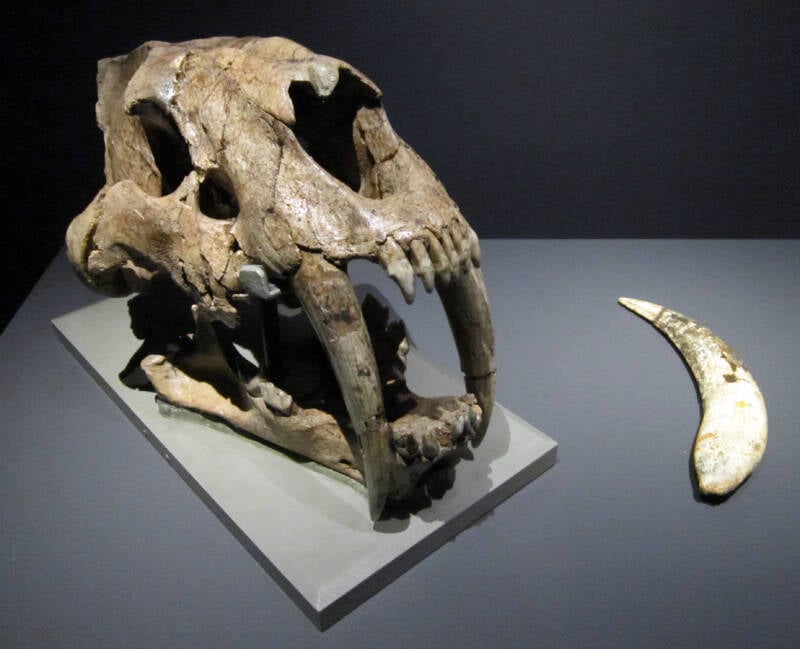Scientists say that the newly studied 16-inch Smilodon populator skull found in southern Uruguay once belonged to an animal that weighed close to 960 pounds.

Wikimedia CommonsIllustration of Smilodon populator, one of the biggest cats ever known, by Charles R. Knight.
During the Pleistocene era some 11,700 years ago, South America was a hotbed of giant predators, among them the Smilodon populator — one of the biggest cats to ever walk the Earth.
Scientists knew that these saber-toothed predators were massive in size but nothing could have prepared them to discover just how gargantuan these cats could get.
As the New York Times reports, a newly examined skull of a Smilodon populator measured a whopping 16 inches in size, a measurement which effectively dwarfed previously found specimens.
“I thought I was doing something wrong,” said Aldo Manzuetti, a doctoral student in paleontology at Uruguay’s University of the Republic. But after several times analyzing the specimen’s measurements, Manzuetti finally stopped.
“I checked the results a lot of times, and only after doing that I realized I hadn’t made any mistakes,” he said. It was clear that the skull specimen once belonged to an animal that tipped the scales at 960 pounds.
With a body mass of that size, these saber-toothed tigers could have possibly hunted prey that was much larger than them in the South American region which was crawling with giant plant-eating animals. The new findings were detailed by Manzuetti and his team in the journal Alcheringa.

Aldo ManzuettiThe newly identified Smilodon populator skull measured a terrifying 16 inches, making it the largest specimen of S. populator to date.
The first fossils of S. populator were unearthed in a Brazilian cave in 1842. They lived during the Pleistocene era when the South American continent was teeming with other large predators like lions, jaguars, and Arctotherium, the biggest bear ever known. The continent was also inhabited by another smaller species of Smilodon.
The newly studied S. populator specimen, which came from the archives at the National Museum of Natural History in Uruguay, is by far the largest fossil of the big cat ever identified to date.
The specimen was dug up in southern Uruguay by an amateur fossil hunter named Ricardo Praderi who later donated it to the museum in September 1989. At the time, archaeological digs around the region had mostly uncovered large herbivores, often the size of a large truck.
The discovery of the S. populator skull has debunked what paleontologists had previously believed about the food chain in that prehistoric ecosystem.
“We’ve always wondered: Who could take down a giant ground sloth?” wondered Kevin Seymour, a paleontologist at Toronto’s Royal Ontario Museum who reviewed the research. “If Smilodon is getting this big, there’s a potential for it to be taking down these giant adult herbivores.”
Although there’s a good chance that the S. populator could have dined on large herbivore prey, there are still a few things to consider.
First, it really depends on the way the S. populator brought down their prey. If their methods were anything like the big cats today then hunting larger prey might be out of the question since that means they would need to wrestle them down to the ground.

Wikimedia CommonsAnother skull specimen of S. populator from the Zoological Museum in Copenhagen.
But the S. populator did have an upper-paw compared to its modern relatives: they could have used their razor-sharp sabers to slice the larger prey in a vulnerable body spot and just wait for them to bleed out from a safe distance.
Hunting larger prey would also be easier if the S. populator hunted in packs. But as of now, there hasn’t been any evidence of that kind of group behavior among the species.
Besides its shocking size, the skull bore another fascinating clue: some damage to the front of the skull suggests that the prehistoric beast had been attacked by another saber-wielding animal.
“If that is true, that is a fascinating finding,” said Margaret Lewis, a paleontologist at Stockton University in New Jersey who was not involved in the new study. “It’s a beautiful thing to look at… I just keep thinking of the power, and the potential things that this animal could have been doing out there in the ecosystem.”
Fortunately, they are no longer around for us to find out.
Next, meet the Entelodont, the horse-sized “hell pig” whose teeth were as thick as human wrists, and read about the 26,000-pound dinosaur that was once the biggest creature to walk the planet.





